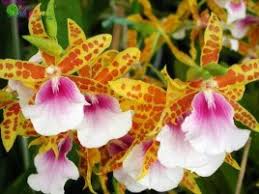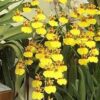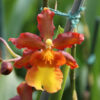### Modern Techniques in the Propagation of Dendrobium Orchids

The enchanting beauty of Dendrobium orchids, commonly known as the Vũ Nữ orchid, has captivated flower enthusiasts and horticulturists around the world. Renowned for their vibrant colors, intricate shapes, and diverse species, these orchids are not only aesthetically pleasing but also have significant cultural and commercial value. This article explores modern techniques in propagating Dendrobium orchids, focusing on methods that enhance efficiency, promote healthy growth, and ensure the successful cultivation of these remarkable plants.
#### 1. Understanding Dendrobium Orchids
Before delving into propagation techniques, it is essential to understand the characteristics of Dendrobium orchids. This genus includes over 1,800 species, with many hybrids, characterized by their unique growth patterns and flower forms. Dendrobiums typically grow in tropical and subtropical regions, thriving in diverse environments ranging from forests to mountainous areas.
These orchids are epiphytic, meaning they grow on other plants without being parasitic, deriving moisture and nutrients from the air, rain, and debris around them. Their growth cycle involves distinct phases: vegetative growth, flowering, and dormancy, each requiring specific care and conditions. Understanding these phases is critical for effective propagation.
#### 2. Traditional Propagation Methods
Historically, Dendrobium orchids have been propagated using traditional methods such as seed propagation, division, and cuttings. While these methods have been effective, they often require significant time and resources.
– **Seed Propagation**: Dendrobium orchids can be grown from seeds, which are tiny and lack endosperm, meaning they need a specific fungus to germinate. This method is labor-intensive and can take years before flowering occurs.
– **Division**: This method involves separating mature plants into smaller sections, each with roots and pseudobulbs. While this method can yield immediate results, it can also stress the parent plant and reduce overall productivity.
– **Cuttings**: Taking stem cuttings from healthy plants can produce new growth. However, this method often results in lower success rates due to potential disease and environmental stress.
While traditional methods still hold value, modern techniques have emerged, providing more efficient and effective ways to propagate Dendrobium orchids.
#### 3. Modern Propagation Techniques
The advancement of technology and horticultural practices has led to innovative propagation techniques that enhance the efficiency and success rate of Dendrobium orchid cultivation. Below are some of the most prominent modern methods:
##### 3.1 Tissue Culture
Tissue culture, also known as micropropagation, is one of the most significant advancements in orchid propagation. This technique involves cultivating plant cells or tissues in a controlled environment, leading to the production of new plants that are genetically identical to the parent plant.
– **Process**: The process begins by sterilizing plant tissues, often taken from shoot tips or nodes. These tissues are then placed in a nutrient-rich agar medium, supplemented with plant hormones that promote growth and rooting. The controlled environment allows for the manipulation of light, temperature, and humidity, creating optimal conditions for growth.
– **Advantages**: Tissue culture offers numerous advantages, including rapid multiplication of plants, disease-free seedlings, and the ability to produce rare or hybrid species that may not be viable through traditional methods. This technique can significantly reduce the time from propagation to flowering, making it a popular choice among commercial growers.
##### 3.2 Clonal Propagation
Clonal propagation involves producing genetically identical plants from a single parent plant. This technique can be achieved through various methods, including tissue culture and vegetative propagation.
– **Benefits**: Clonal propagation ensures consistency in flower quality, size, and color, making it particularly beneficial for commercial growers looking to meet specific market demands. It also allows for the preservation of desirable traits in hybrid varieties.
##### 3.3 Meristem Culture
Meristem culture is a specialized form of tissue culture that focuses on the growth of meristematic tissues, which are responsible for new growth in plants. This technique is particularly useful for producing virus-free plants.
– **Implementation**: The process involves extracting the meristem from the plant and placing it in a sterile culture medium. This method can produce multiple plantlets from a single meristem, offering a high multiplication rate.
– **Advantages**: Meristem culture not only helps produce disease-free plants but also contributes to the conservation of rare Dendrobium species by enabling the preservation of genetic material.
##### 3.4 Hydroponics
Hydroponics, the method of growing plants without soil, has gained popularity in the cultivation of Dendrobium orchids. This technique allows for precise control over nutrient delivery, leading to healthier plants and potentially higher yields.
– **System Design**: Hydroponic systems can be designed using various methods, including nutrient film technique (NFT), deep water culture (DWC), or aeroponics. Each system has its advantages, depending on the specific needs of the orchids.
– **Benefits**: Hydroponics minimizes the risk of soil-borne diseases, improves nutrient uptake, and allows for year-round cultivation. This method is particularly advantageous for commercial growers seeking to optimize production and reduce resource consumption.
#### 4. Environmental Considerations
Successful propagation of Dendrobium orchids requires careful attention to environmental factors. Modern techniques often incorporate advanced technology to monitor and control these factors.
##### 4.1 Climate Control
Dendrobium orchids thrive in specific temperature and humidity ranges. Implementing climate control systems in greenhouses or indoor growing environments can optimize conditions for propagation.
– **Temperature Management**: Maintaining appropriate temperatures during various growth stages is critical. Most Dendrobium species prefer temperatures between 18°C to 30°C (65°F to 86°F), depending on their specific requirements.
– **Humidity Control**: High humidity levels are essential for healthy orchid growth. Modern greenhouses often use automated misting systems or humidifiers to maintain optimal humidity levels.
##### 4.2 Lighting
Lighting plays a crucial role in the propagation of Dendrobium orchids. Understanding the light requirements of different species is vital for ensuring healthy growth.
– **Natural vs. Artificial Light**: While natural light can be effective, many growers utilize artificial lighting systems, such as LED grow lights, to provide the necessary light spectrum for photosynthesis. This is particularly beneficial for indoor propagation where natural light may be limited.
– **Light Duration**: Providing the right amount of light per day (typically 12 to 14 hours) can significantly enhance the growth and flowering of Dendrobium orchids.
#### 5. Nutritional Needs
Providing the right nutrients is essential for the successful propagation of Dendrobium orchids. Modern techniques often employ specialized fertilizers designed to meet the specific nutritional requirements of orchids.
##### 5.1 Fertilizer Types
– **Balanced Fertilizers**: Using a balanced fertilizer with equal parts nitrogen, phosphorus, and potassium (NPK) can promote healthy vegetative growth.
– **Bloom Boosters**: For plants nearing the flowering stage, bloom booster fertilizers with higher phosphorus content can enhance flowering potential.
##### 5.2 Nutrient Delivery
Modern hydroponic systems allow for precise nutrient delivery, ensuring that orchids receive the right amount of nutrients at each growth stage. This targeted approach can lead to healthier plants with improved resistance to diseases.
#### 6. Pest and Disease Management
Effective pest and disease management is crucial in the propagation of Dendrobium orchids. Modern techniques emphasize integrated pest management (IPM) strategies that minimize the use of chemical pesticides while effectively controlling pests.
##### 6.1 Biological Control
Biological control methods, such as introducing beneficial insects (e.g., ladybugs or predatory mites), can help manage pest populations without harming the orchids or the environment. This approach is gaining popularity among organic growers.
##### 6.2 Chemical Treatments
When necessary, the use of targeted chemical treatments can help control specific pests and diseases. Modern products often focus on reduced toxicity and environmental impact.
#### 7. Conclusion
The propagation of Dendrobium orchids has evolved significantly with the advent of modern techniques. From tissue culture and hydroponics to advanced pest management strategies, these innovations have transformed the way horticulturists approach orchid cultivation. By utilizing these methods, growers can enhance efficiency, produce healthy plants, and ensure the continued appreciation of Dendrobium orchids around the world.
As the demand for these stunning flowers continues to grow, embracing modern propagation techniques will be crucial for both commercial and amateur growers alike. Whether you’re a seasoned horticulturist or a novice orchid enthusiast, understanding and applying these modern methods can lead to successful propagation and a flourishing collection of Dendrobium orchids.

